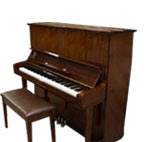Abby Whiteside’s primary prescription for learning was: “Put a rhythm in your body and keep it going.” She encouraged her students to feel the pulsating rhythm underneath the notes that drives the music forward, and to vigorously explore their emotional connection to the music — what she called playing with a basic emotional rhythm.
Whiteside found that many students felt the music very deeply, but manifested their emotional reaction to the music in their bodies — often by tightening certain muscles (and ignoring others altogether), or clenching their jaw, or holding their breath. She taught students to move from the center of their bodies (the torso) to the periphery (fingers) in order to harness the power of the large muscles of the legs, back, and upper arms. This coordination of all of the muscles in the body allows pianists to move freely and easily, and to play with greater control.
Whiteside developed creative solutions to any technical problem that got in the way of a beautiful performance. Students twirled doorknobs to facilitate rotation; they snapped imaginary whips to learn how the upper arm controls the actions of the forearm and hand; they imagined holding a baby bird to make the palms alive for playing. She asked students to get ready to jump up from the piano bench, as if they would immediately start sprinting. Instinctively, students position their bodies in perfect balance against the floor and the seat, and playing becomes easier because the whole body is active.
Abby Whiteside’s visionary work has inspired countless performers and teachers, and her ideas continue to find resonance with performing artists all over the world.










